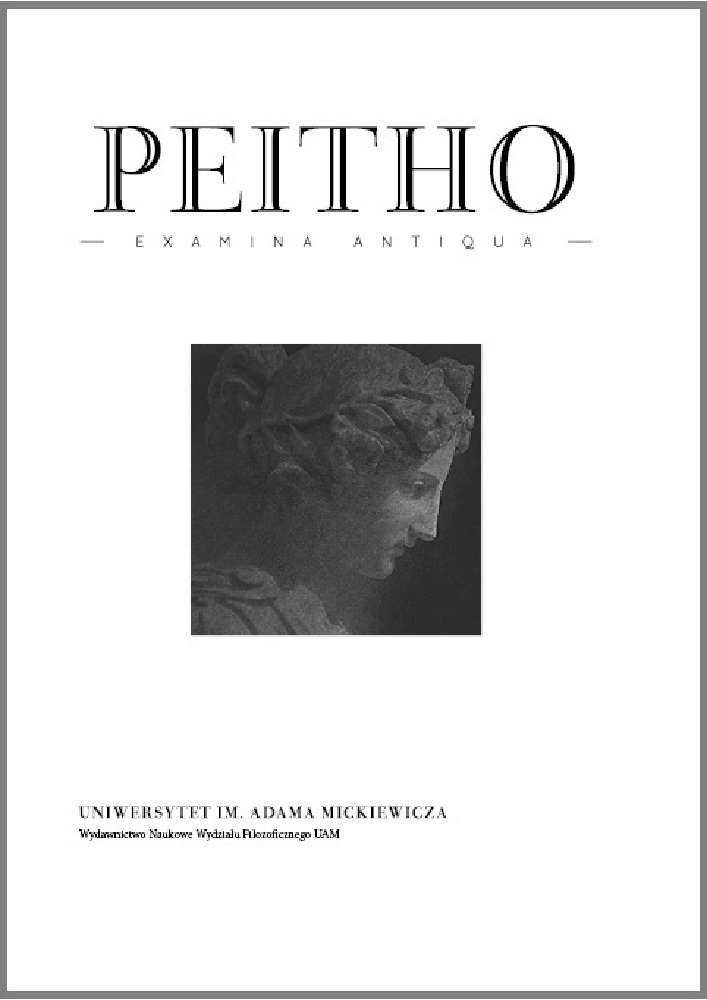Abstract
The two extant versions of Gorgias’ Peri tou mē ontos (PTMO) have been preserved by an anonymous author (MXG) and by Sextus Empiricus (S.E.). Both versions have been differently interpreted by scholars who examine either the doctrine or the rhetorical-communicational dimension (the first option being dominant). When comparing the PTMO with the rest of Gorgias’ works, the present paper aims to demonstrate that S.E. offers a more precise account of Gorgias’ modus argumentandi. Thus, S.E. shows the following, typical features of Gorgias’ demonstrative reasoning: 1) application of demonstrandum and quod erat demonstrandum, 2) continuous employment of reductio ad absurdum and 3) a refined formulation of the principle of non-contradiction (similar to the one in Pal. 25). The MXG, on the other hand, is accurate in the discussion of particular arguments (e.g. the third kephalaion), but presents an interpreter who is more interested in questioning Gorgias rather than doing justice to his thought. Hence, this article concludes that it was S.E., who had the text or at least a relatively accurate summary of the PTMO.
References
Arrighetti, G., 1952, “Sul valore di epilogizomai, epilogismos, epilogisis nel sistema epicureo”, La parola del Passato 7, pp. 119–144.
Bredlow, L. A., 2016, Gorgias de Leontinos, De lo que no es o de la naturaleza. Los testimonios, Barcelona.
Bremond, M., 2017, Lectures de Mélissos. Édition, Traduction et Interprétation des témoignages sur Mélissos de Samos, Berlin – Boston.
Calogero, G.,1932, Studi sull’Eleatismo, Firenze.
Classen, C. J., 1992, “L’esposizione dei sofisti e della sofistica in Sesto Empirico”, Elenchos 13, pp. 57–79.
Cunsolo, C., 1996, “L’opera ‘Sul non essere’ di Gorgia. Uno sguardo alle maggiori linee interpretative della critica”, Bollettino della Società Filosofica Italiana 158, pp. 7–17.
de Lacy, P., 1958, “Epicurean Epilogismos”, The American Journal of Philology 79, pp. 179–183.
Gheerbrant, X., 2017, Empédocle, une poétique philosophique, Paris.
Gigon, O., 1936, “Gorgias Über das Nichtsein”, Hermes 71, pp. 186–213.
Giombini, S., 2012, Gorgia Epidittico. Commento filosofico all’Encomio di
Elena, all’Apologia di Palamede, all’E¬pitaffio, Perugia.
Giombini, S., 2015, “Gorgia esperto di diritto”, in: I. Pozzoni (cur.), Schegge di filosofia antica e medioevale, Villasanta, pp. 65–77.
Ioli, R., 2009, “Gorgia scettico? Una riflessione sulla presenza del sofista nelle opere di Sesto Empirico”, Rhei¬nisches Museum für Philologie 152, pp. 331–357.
Ioli, R., 2010, (cur.), Gorgia di Leontini. Su ciò che non è, Hildesheim – Zürich – New York.
Ioli, R., 2013, Gorgia. Testimonianze e frammenti, Roma.
Janáček, K., 2008, “Analyse der Berichte über die Philosophie des Gorgias” (1932), in: J. Janda, F. Karfik (eds.), Studien zu Sextus Empiricus, Diogenes Laertius und zur pyrrhonischen Skepsis, Berlin – New York.
Kerferd, G. B., 1955, “Gorgias on Nature or That Which Is Not”, Phronesis 1, pp. 3–25.
Kurfess, C. J., 2012, Restoring Parmenide’s Poem: Essays toward a new Arrangement of the Fragments based on a Reassessment of the original Sources, University of Pittsburgh, [Doctoral Dissertation, not published yet].
Loenen, J. H. M. M., 1959, Parmenides, Melissus, Gorgias, A reinterpretation of Eleatic Philosophy, Assen.
Marcacci, F., 2008, “Sesto Empirico e la dimostrazione matematica: momenti di una ricerca”, Aquinas 1–2, pp. 29–42.
Mugler, Ch., 1958, Dictionnaire historique de la terminologie géométrique des Grecs, Paris.
Pulpito, M., 2015, “La versione di Seniade e il parricidio performativo di Platone”, in: G. Casertano et al., Da Parmenide di Elea al Parmenide di Platone, Sankt Augustin, pp. 182–191.
Ramírez Vidal, G., 2016, La invención de los sofistas, Ciudad de México.
Rossetti, L., 2006, “Oltre il demonstrandum. La dimensione metacognitiva dei testi paradossali nell’età dei Sofisti”, Méthexis 19, pp. 125–138.
Rossetti, L., 2015, “Storia e preistoria della filosofia: alcune date cruciali”, Archai 15, p. 11–20.
Rossetti, L., 2017, “Trilemmi: Il PTMO di Gorgia tra Zenone e Melisso”, Peitho 8, pp. 155–172.
Sedley, D., 1992, “Sextus Empiricus and the Atomist Criteria of Truth”, Elenchos 13, pp. 21–56.
Spinelli, E., 2004, “L’esperienza scettica: Sesto Empirico fra metodologia scientifica e scelte etiche”, Quaestio 4, pp. 25–43.
Wesoły, M., 1983/1984, “L’argomento proprio di Gorgia”, Annali dell’Istituto Italiano per gli Studi Storici 8, pp. 15–45.
Wesoły, M., 1986, “Le tecniche argomentative di Gorgia intorno alla tesi che nulla esiste”, L. Montoneri, F. Romano (cur.), Gorgia e la Sofistica. Atti del Convegno Internazionale (Lentini-Catania, 12–15 dicembre 1983), Catania, pp. 311–341.
Wesoły, M., 2013, “La «dimostrazione propria» di Gorgia”, Peitho 4, pp. 159–188.
License
Peitho provides immediate open access to its content on the principle that making research freely available to the public supports a greater global exchange of knowledge.
